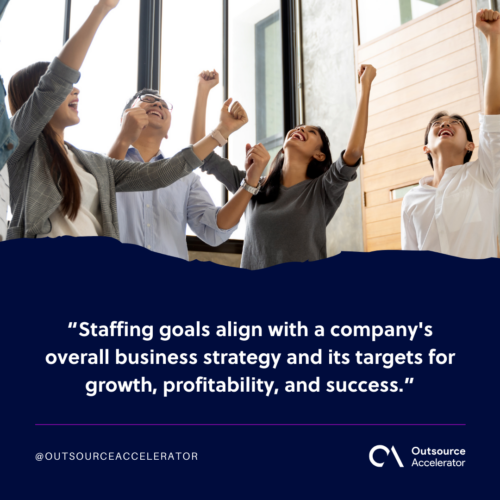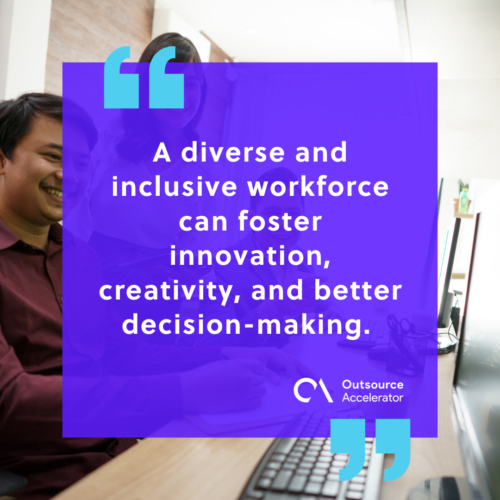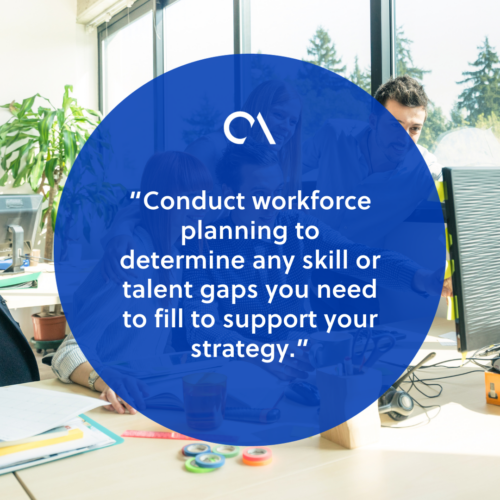How to set staffing goals for your business

As a business owner, one of your primary objectives is to ensure that you have the right people in the right roles to help you achieve your goals.
Yet, businesses find it challenging to oversee their workforce and prepare for the future.
Anna Bjerde, the World Bank Managing Director for Operations, even stated that “now is a critical time to generate jobs and power economies by investing in people.”
The complexities of employee turnover, skill deficiencies, surplus staff, reduced productivity, and the constant shifts in the business arena contribute to these difficulties.
However, having well-crafted staffing goals can effectively address these concerns.
This article discusses the importance of setting staffing goals and types of staffing plans. It also lists important staffing goals to achieve and how to develop a staffing plan.
What are staffing goals?
Staffing goals are strategic objectives aimed at optimizing your workforce to meet your business’s specific needs.
These goals go beyond mere headcounts — they involve defining the skills, competencies, and roles required to achieve your organization’s mission.
Staffing goals align with a company’s overall business strategy and its targets for growth, profitability, and success.

4 types of staffing plans
A staffing plan is a structured strategy that outlines an organization’s approach to recruiting, hiring, and managing its workforce. It exists to meet present and future business needs effectively.
There are several types of staffing plans that business leaders can adopt to achieve their staffing goals:
- Short-term staffing plan. This plan is for filling immediate and short-term needs. It’s often used for seasonal work, special projects, or when employees go on leave.
- Long-term staffing plan. It is often used when a company expands or grows into new markets or products.
- Succession staffing plan. This plan ensures the smooth transition of key organizational roles when an employee leaves, retires or is promoted.
- Strategic staffing plan. A strategic staffing plan aligns an enterprise’s staffing needs with its overall business strategy.
Importance of staffing goals in a company
Staffing goals are essential in ensuring a company has the right people to achieve its business objectives.
They provide a clear roadmap for hiring, training, retention, and overall employee management. By setting staffing goals, an organization can:
- Identify the skills, knowledge, and experience it needs in its employees
- Define the roles and responsibilities of each employee
- Ensure that its workforce is diverse and inclusive
- Foster employee engagement, satisfaction, and retention
- Provide opportunities for employee growth and development
- Enhance its brand reputation and attract top talent
Staffing goals to achieve
Here’s a comprehensive list of staffing goals to consider when crafting your talent acquisition strategy:
1. Hire the right people
Finding and hiring the right people is critical for achieving your staffing goals. Make sure your hiring process covers all your objectives.
Establish clear job descriptions, review resumes, and conduct interviews to ensure you are getting the best candidates.
2. Train and develop employees
Proper training and development can ensure that workers are properly equipped to perform their duties. Offer opportunities for continued education and skills training for your current employees.
3. Retain employees
Retaining employees can improve morale, reduce turnover, and save your company time and money spent on hiring and training new employees.
Offer enticing compensation packages, career growth opportunities, and work-life balance.
4. Maintain a diverse and inclusive workforce
A diverse and inclusive workforce can foster innovation, creativity, and better decision-making. Ensure your organization has a diversity and inclusion policy and reviews it regularly.

5. Foster employee engagement
Engaged employees are more productive, satisfied, and less likely to leave. Provide opportunities for feedback, recognition, and collaborative work environments.
An engaged workforce brings only positives to your overall organizational culture.
6. Succession planning
Implementing a succession plan is crucial for the long-term success of your business.
Identifying and developing potential successors for key leadership positions ensures a smooth transition when current leaders leave or retire.
How to develop a staffing plan
To develop a robust staffing plan, follow these key steps:
1. Understand your business objectives
Before developing a staffing plan, you must understand your company’s overall business strategy. This will enable you to identify the staffing needs required to accomplish your goals.
2. Determine your current workforce
Determine your team’s current members, their skills, and experience. Assess whether any roles need to be restructured or revised to improve productivity and efficiency.
3. Identify staffing needs
Identify the roles and skills your organization needs to achieve its business objectives. Conduct workforce planning to determine any skill or talent gaps you need to fill to support your strategy.
Consider as well any future staffing needs that you may experience.

4. Develop an action plan
Develop a plan to attract, hire, train, and retain the right people. Identify the needed resources and set recruitment, training, and development timelines.
5. Monitor and evaluate your staffing plan
Continually monitor and evaluate your staffing plan to ensure it remains relevant and effective. Regularly review and revise your plan as needed to ensure you achieve your staffing goals.
Further, if you need additional support in this matter, you can always count on the right third-party service providers.
Sourcefit, for example, can leverage its expertise to establish recruitment, training, and development timelines aligned with your specific requirements.
Strategic workforce planning can help you optimize your business and maximize productivity.







 Independent
Independent




